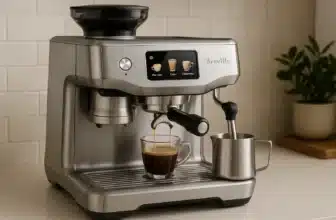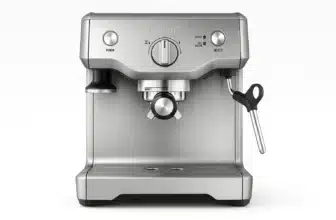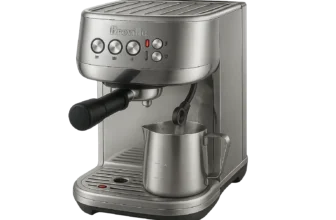
OneHundredCoffee is reader-supported, and some products displayed may earn us an affiliate commission. Details
I didn’t plan to fall for the Breville Infuser (model BES840XL). I just wanted consistent espresso at home without playing boiler roulette or surrendering my counter to a monster machine. Yet, after months of pulling shots every morning (and more than a few sleepy evenings), dialing in dozens of coffees, steaming milk for friends, and cleaning it like a ritual, the Infuser quietly won me over. It’s not flashy. It’s not the fanciest machine on the market. But it’s steady, forgiving, and thoughtfully designed—exactly what an everyday espresso companion should be.
I’ve brewed with it on rushed weekdays and lazy weekends; I’ve tested light Scandi roasts that demand precision and medium-dark blends that love a simpler approach. I learned where this machine shines, where it needs a nudge, and which add-ons make it sing. Below is exactly how it behaves in real life, section by section, the stuff you only learn when you live with a machine instead of just reading the spec sheet.

Breville Infuser Espresso Machine (BES840XL)
Key Features
- 3.3 oz dosing control via infusion pre-wetting
- Digital PID temperature control
- 9-bar pressure extraction
- Manual steam wand for texturing microfoam
- 58 mm commercial-style portafilter with pressurized basket
Why We Like It
The Infuser blends control and automation: its pre-infusion dampens channeling, while the PID system keeps extraction stable. A great “next step” machine for those wanting quality shots without a steep learning curve.
Pros
- Infusion pre-wetting reduces channeling
- PID system helps maintain shot temperature
- Straightforward workflow with good upgrade path
- 58 mm portafilter compatibility
Cons
- No automatic milk texturing — manual wand only
- Pressurized basket less ideal for fully free-style espresso
Bottom Line
A balanced, quality machine perfect for those transitioning from entry-level to more serious espresso—combining precision and control without being overbearing.
Price on AmazonHere’s my detailed review.
Big Picture: Who the Infuser Is For
If you want real espresso with genuine low-pressure pre-infusion, simple but effective temperature management, easy user controls, and a compact footprint—without the price and learning curve of prosumer gear—the Infuser fits the bill. It’s a sweet spot between “entry-level beginner” and “I want café-quality but still like counter space.” You’ll still need a good grinder (more on that), but the machine itself brings repeatability to a price and size bracket that many home baristas appreciate.
Our Favorite Breville Picks Under $500 at a Glance
| Image | Product | Features | Price |
|---|---|---|---|
Best Semi-Automatic Espresso Entry  |
| Price on Amazon | |
Best Compact Espresso Machine  |
| Price on Amazon | |
Professional Dual Boiler Espresso  | Price on Amazon | ||
Compact Barista-Quality Espresso  |
| Price on Amazon |
Unboxing & First Setup: My First Morning With the Infuser
Out of the box, Breville’s tidy packaging and included accessories make setup painless: the 54 mm portafilter, single- and double-shot baskets (single-wall and dual-wall), a basic tamper that magnetically docks to the machine, cleaning tools, water filter, and a quick-start guide. I flushed the system, primed the group head and steam wand, installed the water filter in the tank, and was pouring my first espresso practice shots within 20 minutes.
Two small but thoughtful touches stood out early:
- Auto-purge: after steaming, the machine purges the heat from the thermocoil to recover faster for brewing.
- Hot water outlet: incredibly handy for topping up Americanos or preheating cups without hijacking the steam wand.
Size & Design (Countertop Reality)
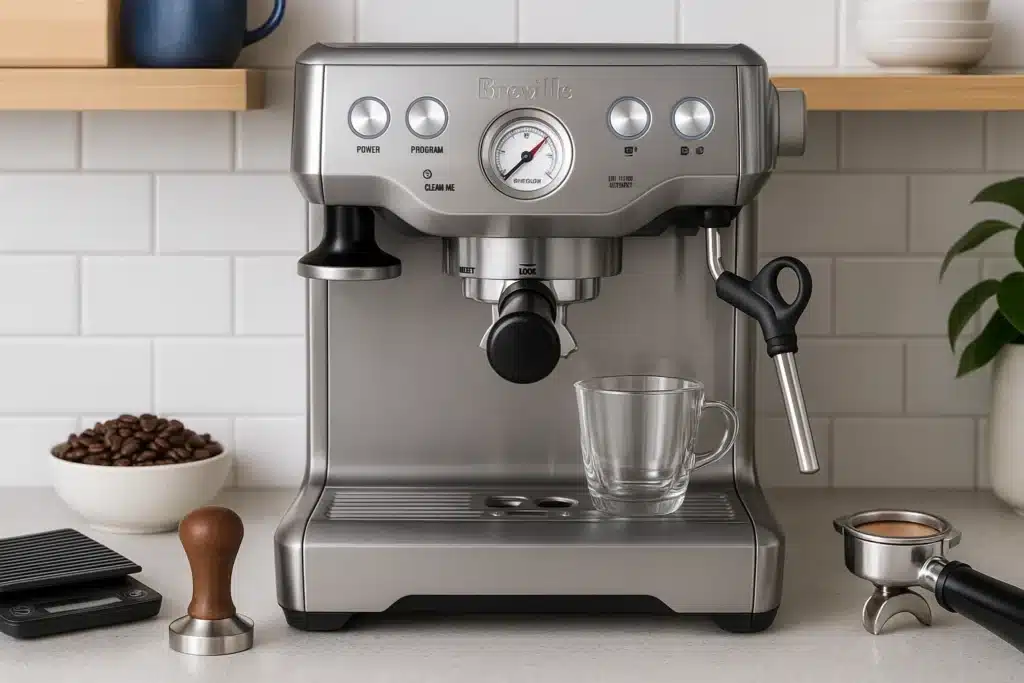
On my apartment-sized counter, the Infuser hits a Goldilocks zone. It’s compact without feeling toy-like and feels stable when locking in the portafilter. The brushed stainless steel front and sides shrug off fingerprints better than mirror-polished machines I’ve owned. Buttons are firm; the knob for steam/hot water has a confident detent. The drip tray pulls out smoothly, and the “Empty Me!” float pops up when it’s time—cute and genuinely useful.
A practical note: there’s enough cup-warming space on the top for two or three demitasses or a couple of small cappuccino cups. I leave a microfiber cloth up there, and the heat helps dry it out between sessions.
Colors (Kitchen Aesthetics)
Mine is the classic Brushed Stainless Steel, and I’m glad I chose it. It complements other appliances without screaming for attention. The finish looks good under natural morning light and also at night under warmer kitchen bulbs. Because it’s neutral, I can rotate cups, scales, and accessories without the color clash you get when you pick a bold appliance color and then change your kitchen vibe later.
User Interface (Buttons That Do What You Expect)
The UI is delightfully simple: dedicated 1 CUP and 2 CUP buttons (both programmable), a POWER button, and a PROGRAM button. A pressure gauge in the center shows how your shot is extracting—yes, it’s not a lab-grade transducer, but it’s very helpful. I programmed my doubles to ~30 seconds and singles to ~28 seconds (from first drip), then I use manual overrides when a particular coffee wants longer or shorter. The combination of tactile buttons and that center gauge makes the learning curve feel low and the confidence curve feel high.
Steam/hot water is controlled by a knob. Turn left for hot water (through the separate spout), right for steam. It’s intuitive and quick, and I’ve never overshot or fumbled mid-drink.
Water Tank (Capacity, Refills, Filtration)
The rear-mounted tank holds plenty for home use (think multiple drinks before a refill). It lifts straight up with a handle; I usually remove and fill at the sink rather than pouring over the back to avoid drips. The included water filter snaps into the tank and lasts several weeks, depending on use and water quality. Using filtered water plus regular descaling means I spend more time making espresso and less time chasing limescale gremlins.
One tip from daily use: seed the tank with pre-heated water (not boiling) if you expect to make a big milk round for guests. It shortens warm-up and steam-recovery time.
Coffee Grinder (It Doesn’t Have One—That’s a Good Thing)
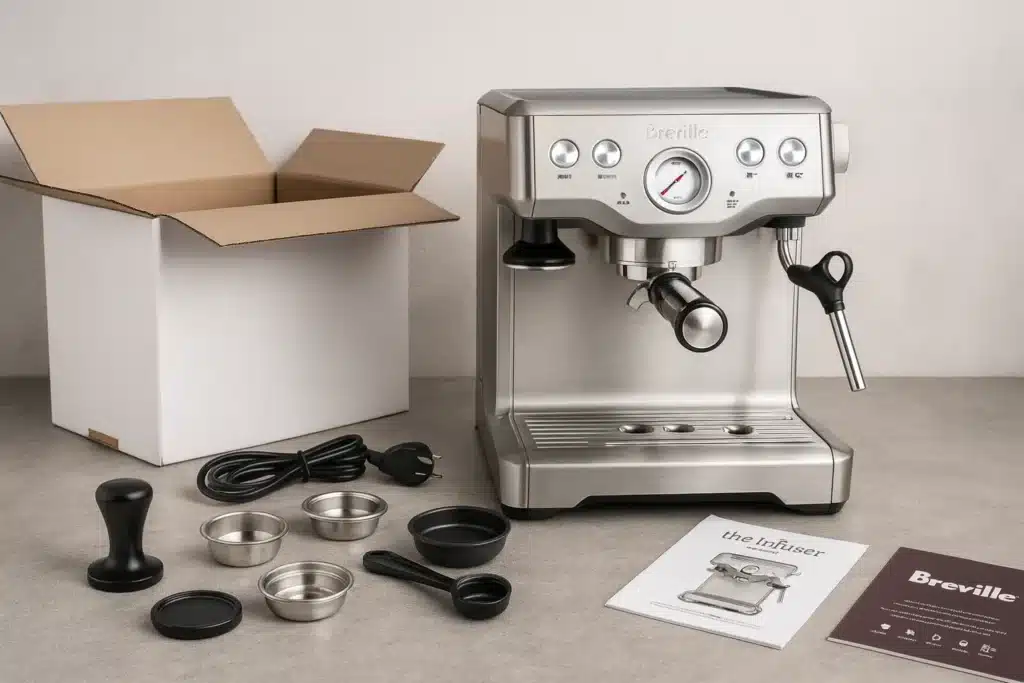
The Infuser intentionally doesn’t include a grinder. That’s not a drawback; it’s a strength. Pairing a separate burr grinder gives you upgrade freedom and better shot tuning across roast levels. Pressurized baskets will let a basic grinder limp along, but if you’re serious about espresso, use non-pressurized (single-wall) baskets and a capable burr grinder.
What’s worked for me: I keep one grinder setting marked for medium roasts, another notch finer for light roasts. The Infuser’s pre-infusion and PID-style temperature control (more on that below) help “smooth out” the dial-in process, but your grinder is still the star of extraction. If you’re upgrading from a blade grinder, brace yourself: the jump in flavor clarity is huge.
Portafilter & Baskets (54 mm—Small, But Mighty)
Breville’s 54 mm portafilter is a hallmark of their mid-range machines. Some purists prefer 58 mm, but in practice, the 54 mm works beautifully—especially with proper distribution and a decent tamper. The stock tamper is serviceable and cleverly magnetically docks to the machine’s face, but I eventually moved to a heavier 54 mm tamper plus a distribution tool for more even extractions with lighter roasts.
The included baskets cover both pressurized (dual-wall) and non-pressurized (single-wall) use. For fresh coffee and a good grinder, single-wall delivers the real espresso experience. If you’re using older supermarket beans or an underpowered grinder, dual-wall can help you produce something tasty while you upgrade.
Automatic or Manual Dose (Programmability That Matters)
Out of the box, the 1 CUP and 2 CUP buttons deliver consistent volumes, but the beauty here is programmability. I programmed the 2-cup to give me ~38–40 grams out in roughly 28–32 seconds (from first drip) with an 18 g dose for classic modern espresso. For a sweet ristretto, I’ll hit manual and stop around 25–28 g out. If your coffee changes, re-programming takes seconds and sticks until you change it again. This kind of “good enough automation” with easy manual override is exactly what makes the Infuser pleasant to live with.
Pre-Infusion & Heating System (Gentle Start, Predictable Heat)
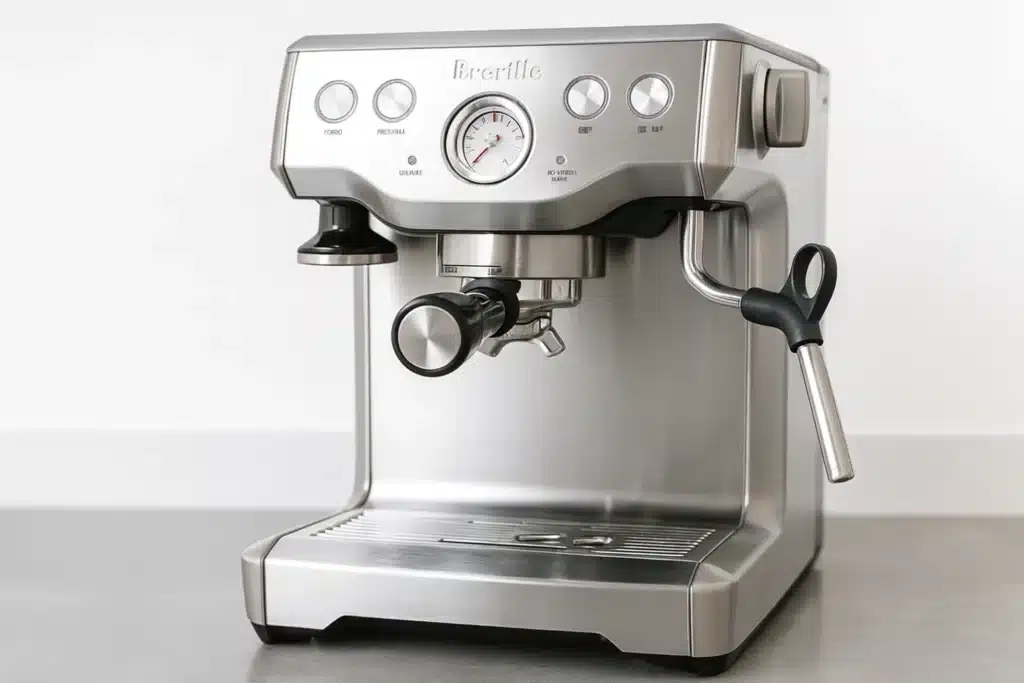
This is the Infuser’s secret sauce. True to its name, it uses low-pressure pre-infusion to gently saturate the puck before ramping up to full pressure. In practice, that means fewer channeling disasters and more forgiving extractions—especially when you’re dialing in a new coffee or your distribution wasn’t museum-perfect at 6 a.m.
Heating is via a thermocoil paired with electronic temperature control (Breville lets you nudge brew temp a few notches if needed). It’s not a dual-boiler thoroughbred, but it’s steady and quick to recover for back-to-back drinks. After steaming, the auto-purge cools the system so your next shot isn’t scorched—a small but important feature that many rivals skip at this price.
Cup Used Size & Clearance (Real-World Cup Logistics)
Clearance under the spouts accommodates demitasses and standard cappuccino cups easily. For taller latte glasses, I either remove the drip tray grid or pull into a small cup, then pour into the tall glass. The hot water spout makes building an Americano neat and tidy: I pull the shot, then add hot water without moving the cup to another appliance. It sounds small; it’s a daily joy.
Tamping (From “It Works” to “It Clicks”)
With the included tamper, I was making drinkable espresso on day one. The handle is light, but the magnetic dock means it’s always exactly where I expect it. After a few weeks, I swapped to a heavier 54 mm tamper and added a palm distributor. That took my consistency up another notch—especially on light roasts where tiny prep errors show up in the cup.
If you’re new to tamping, aim for level, consistent pressure, and keep your puck prep routine the same each time. The Infuser’s pre-infusion is your friend while you build the muscle memory.
Temperature Control (Fine-Tuning Without Headaches)
You can adjust brew temp in small steps to better suit lighter or darker roasts. I leave mine at default for medium roasts, bump it up a notch for very light washed Ethiopians, and drop it a notch for darker blends that can taste bitter if too hot. The change is subtle and cumulative—use it to shift the center of flavor rather than to fix a fundamentally bad grind or dose.
Because the machine auto-purges after steaming, I can return to pulling a shot fairly quickly without temperature surfing. That’s huge for rhythm.
Milk Foam / Frother (Microfoam That Behaves)
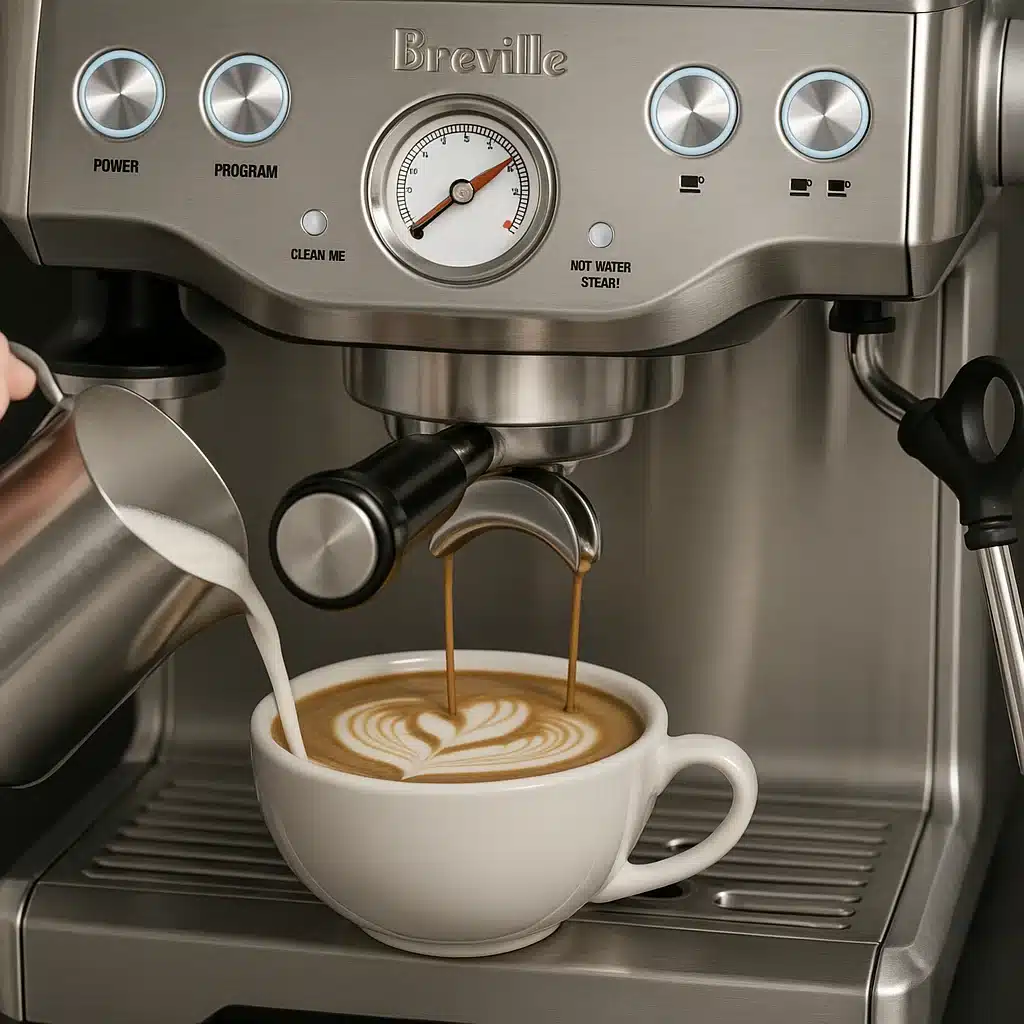
The steam wand is nimble and capable. It’s not commercial-boiler fierce (thankfully, for beginners), but it absolutely produces silky microfoam suitable for latte art with a little practice. I consistently hit the sweet spot for cappuccinos and flat whites. If I’m steaming 12 oz for a big latte, I start with slightly warmer water in the pitcher to keep times reasonable. Purge, position just below the surface to introduce air, then roll. The wand wipes clean easily, and I always give it a short post-steam purge to keep the tip clear.
If you’ve struggled with foam on entry-level machines, the Infuser’s wand will feel like an upgrade.
Daily Workflow: My Morning Routine
- Warm-up & Prep
I preheat cups with the hot water outlet, purge the group for a second, and wipe the basket dry. - Grind & Dose
18 g for a double is my baseline. I WDT (a quick distribution stir), tap to settle, and tamp level. - Pull
2-cup button (programmed) gets me ~38–40 g out in ~30 seconds. I watch the gauge and stream; if it blondes early, I note I’ll grind finer next shot. - Milk
Switch to steam, purge, stretch, and roll milk to a silky finish. Auto-purge brings me back to brew temps quickly if I’m making a second round. - Cleanup
Knock the puck, flush the group, wipe and purge the wand, empty the drip tray when the float says it’s time.
The whole routine is predictable, which is exactly what I want before coffee.
Taste Results (Shots & Milk Drinks)
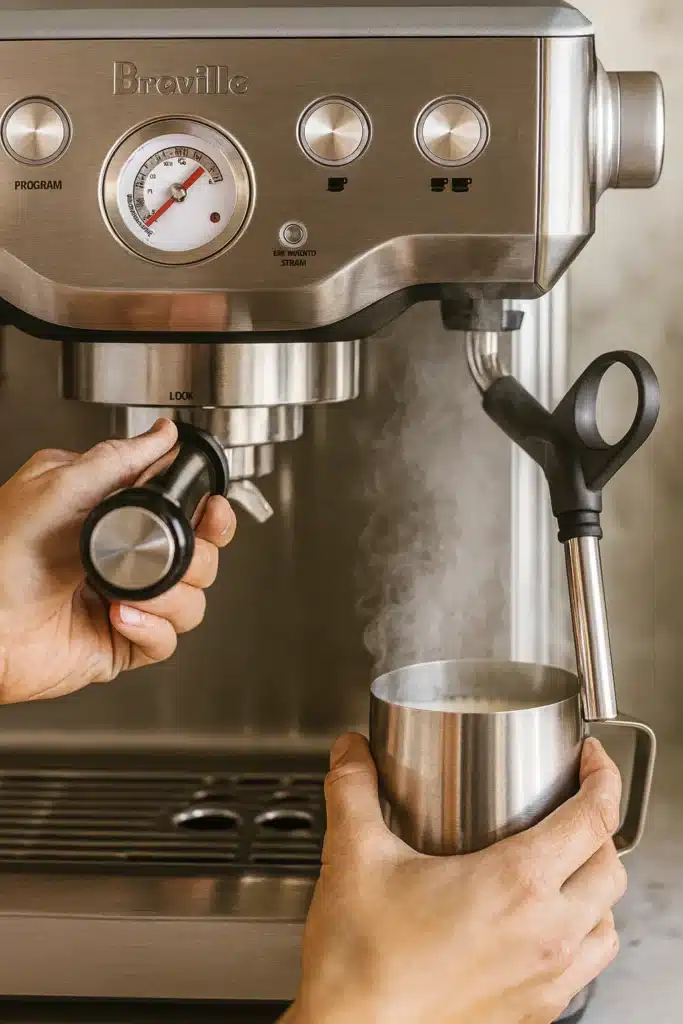
With a good grinder and fresh beans, the Infuser rewards you: syrupy chocolate-hazelnut shots with classic blends; floral citrus shots with delicate acidity on washed Africans; jammy berry notes on naturals—all very attainable. In milk, the sweetness carries through, and I can keep a cappuccino lively rather than flat. Are you hitting the 1% margins of a dual-boiler machine with a massive grouphead? No. But for home use, the cup quality-to-effort ratio is excellent.
Cleaning, Descaling & Maintenance
Daily: purge/wipe the wand, flush the group for a second, rinse the baskets and portafilter.
Weekly: detergent backflush with the cleaning disc, wipe the shower screen, remove and rinse the drip tray and grate.
Monthly/Quarterly (depends on water): descale and replace the water filter.
Breville’s cleaning reminders and included tablets make this easy. The machine feels designed by people who actually maintain machines.
Noise, Speed & Energy
Pump and steam noise are normal for a machine this size—lively but not obnoxious. Warm-up is quick; from cold to first shot feels like “grind your beans” time rather than “go fold laundry” time. Because it’s a thermocoil, it’s more energy-sensible than keeping a big brass group idling all morning.
Reliability & Build Quality
After months of daily use, the buttons and knob still feel crisp, the wand swivels smoothly, and there are no odd squeaks or rattles. The drip tray’s fit remains snug. The only visible wear on mine is the expected polishing of the portafilter ears from locking in and out—a badge of honor.
Troubleshooting & Tips (What I Learned The Hard Way)
- Channeling? Do a light WDT and tamp level. The pre-infusion helps, but puck prep still matters.
- Shots run fast? Finer grind > more dose > firmer tamp—in that order.
- Bitter or “ashy”? Drop the brew temp one notch, coarsen slightly, and shorten the shot.
- Sour? Finer grind, a touch more yield, or bump the temp up one notch.
- Milk struggles? Start with cooler milk and a smaller pitcher; learn the “paper-tearing” sound just below the surface, then drop to roll.
Who It’s For (And Who Might Look Elsewhere)
Great for:
- New-to-intermediate home baristas who want real pre-infusion, straightforward controls, and dependable results.
- Anyone who values compact design and smart details (auto-purge, hot water spout) over a feature circus.
- Households that make 1–4 drinks at a time, most days of the week.
Maybe not for:
- People who regularly make six milk drinks back-to-back and want blazing steam power—consider a heat-exchanger or dual boiler.
- Tinkerers who crave 58 mm ecosystems and mod-friendly machines.
- Those who insist on an integrated grinder (there are “Express”-style machines for that, with the trade-offs that come with built-ins).
Competitor Comparison Table
| Machine | Boiler/Heat | Pre-Infusion | Temp Adj/PID-style | Portafilter | Grinder | Steam Wand | Notable Strength |
|---|---|---|---|---|---|---|---|
| Breville Infuser BES840XL | Thermocoil | Yes (low-pressure) | User-adjustable steps | 54 mm | No | Capable home wand | Forgiving, compact, auto-purge, hot water outlet |
| Breville Barista Express | Thermocoil | Yes | Limited | 54 mm | Integrated | Similar | All-in-one convenience; upgrade path is trickier due to built-in grinder |
| Gaggia Classic Pro | Single boiler | Minimal | No stock PID | 58 mm | No | Stronger wand | Rugged, mod-friendly; more manual temp management |
| Rancilio Silvia | Single boiler | Minimal | No stock PID | 58 mm | No | Powerful wand | Café-like feel; temperature surfing unless you add PID |
| De’Longhi Dedica Arte | Thermoblock | Simulated | No | ~51 mm | No | Adequate | Ultra-slim footprint; more “compact lifestyle” than “enthusiast espresso” |
Why I’d still pick the Infuser for many homes: a genuinely helpful pre-infusion, quick recovery via auto-purge, a hot-water outlet, and “just enough” temperature control—all in a compact, tidy package that teaches good habits without punishing you for tiny mistakes.
Buying Guide: How To Choose Between These
- Want fewer boxes and a tidy look? Barista Express is tempting, but you’ll likely outgrow the built-in grinder. The Infuser + a good separate grinder ages better.
- Want 58 mm and a more “pro” feel? Gaggia Classic Pro or Rancilio Silvia—but plan on a PID or learn temperature surfing.
- Tiny kitchen, espresso now, minimal fuss? Dedica Arte is friendly, but it’s a different class.
- Value consistency and a low-stress workflow? Infuser. Every day of the week.
Customer Guide: Getting the Best From the Infuser
1) Invest in the grinder. Single-wall baskets need a capable burr grinder. Your espresso quality lives or dies here.
2) Start with a baseline recipe. 18 g in, 36–40 g out in ~30 seconds. Adjust for each coffee.
3) Use pre-infusion to your advantage. It’s not a magic wand, but it’s a safety net—especially on light roasts.
4) Learn the steam wand rhythm. Purge, stretch, then roll. Smaller pitchers are easier when learning.
5) Keep your routine tight. WDT (or at least finger-leveling), tamp level, flush, wipe, purge.
6) Maintain it. Backflush weekly, descale per water and use, and change filters. Your future self thanks you.
Pros & Cons (From My Kitchen, Not a Spec Sheet)
Pros
- Genuine low-pressure pre-infusion = fewer ruined pucks when you’re learning.
- Temperature control steps + auto-purge = stable, repeatable workflow.
- Hot-water spout for Americanos and cup preheating.
- Compact, good-looking, and thoughtfully laid out.
- Great “confidence machine” for new and intermediate users.
Cons
- A single thermocoil means you’re not steaming and brewing simultaneously.
- The 54 mm ecosystem is excellent, but less “industry standard” than the 58 mm.
- The stock tamper works, but you’ll likely want to upgrade.
- Steam power is perfectly adequate, not blistering.
Frequently Asked (The Stuff I Get DMs About)
Can it make café-quality espresso?
Yes—within reason and with a good grinder. I get delightful shots daily, and friends ask for seconds.
Is it beginner-friendly?
Absolutely. The UI is clear, the pre-infusion is forgiving, and the machine rewards good habits as you improve.
Will I outgrow it?
Possibly, if you eventually want dual-boiler speed, 58 mm universality, or deep modding. But many home baristas happily live at this level long-term.
What’s the first accessory to buy?
A proper 54 mm tamper and a distribution tool. If you don’t already have a good grinder, that’s priority zero.
My Personal Experience: The Moments That Made Me Smile
There’s a point in the morning when the crema settles and the kitchen smells like toast and orange blossom—that was a washed Ethiopian dialed a hair finer with the brew temp bumped one notch. Or a rainy Sunday cappuccino where the microfoam was glossy enough to pour a half-decent tulip without thinking. Those little victories became routine with the Infuser because it made my routine solid: predictable temp, gentle pre-infusion, no “did I scorch the boiler after steaming?” anxiety. I don’t have to fight the machine; I get to taste the coffee.
I’ve used pricier gear; some of it was incredible. But the Infuser’s day-to-day friendliness has me reaching for it even when other machines are sitting nearby. That says a lot.
Final Verdict: Why I’m Happy I Chose the Infuser
The Breville Infuser BES840XL is the machine I recommend when someone asks for real espresso at home without the stress. It’s compact, consistent, and cleverly equipped with features that matter (pre-infusion, temperature control, auto-purge, hot water). It expects you to bring a good grinder and decent puck prep—and then it rewards you with confident, repeatable results. If you want café-level clarity from modern light roasts or cozy chocolate-heavy cappuccinos on a Tuesday, it delivers both with grace.
Is it the last espresso machine you’ll ever own? Maybe, maybe not. But it’s an excellent machine to grow with, not just “start on.” I bought it to make mornings easier; I kept it because it made my coffee better.
Bottom line: For many home baristas, the Infuser is a sweet-spot machine—thoughtful, forgiving, and genuinely enjoyable to use. I’d buy it again.
Quick Start Recipe Bookmarkable)
- Dose: 18 g (double)
- Yield: 38–40 g
- Time: ~30 s from first drip
- Temp: Default; +1 for very light roasts
- Milk: 150–170 ml for a cappuccino; stretch to 30–40°C, then roll to ~55–60°C
Care & Maintenance Cheatsheet
- After every session: Flush group 1–2 s, purge/wipe wand
- Weekly: Backflush with tablet, rinse drip tray, wipe shower screen
- Monthly/Quarterly: Descale (depends on water), replace tank filter
If you’re standing in a kitchen aisle or scrolling product pages, wondering whether the Infuser is “enough,” take it from someone who lives with it: it’s more than enough for delicious espresso at home—and it’s friendly enough to make you want to keep practicing until your best cup becomes your everyday cup.



